After a brief hiatus, Bramble Berry LabColors are back and better than ever!
LabColors will be easier to use (see the first picture in this post for an example of spots from clumpy color), and you’ll have vibrant colorants that will show up beautifully in your products. We’re also changing the preservative to Optiphen ND, so don’t forget to update your product ingredient lists!
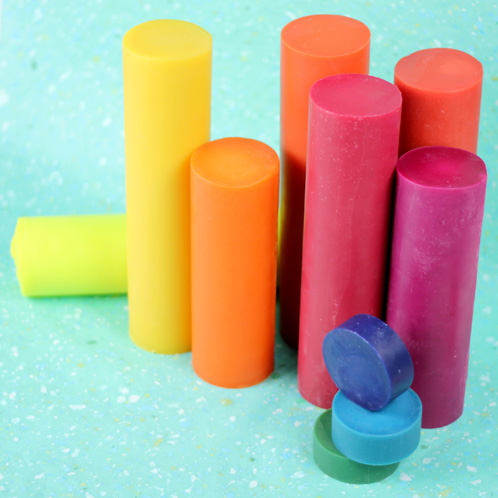
To keep things simple, the sizes of our LabColors will also change. Our new recommended dilution rates for LabColor use in both cold process and melt and pour soap are below:
Small dilutes into 4 to 8 ounces of water
Large dilutes into 8 to 16 ounces of water
Jumbo dilutes into 50 to 100 ounces of water
Despite the changes, the way you dilute LabColors is still the same. For a complete guide to diluting LabColor, refer to this blog post.
You may notice a large variation in how much water we recommend adding for each size. This is because if you plan on using the LabColors in cold process soaps, you’ll want to dilute the color on the lower end of the recommended spectrum to produce a more concentrated color. In our experience, we’ve found that diluting the small sized bottle in 4 oz. of water produces the best result. It produces a strong, vibrant color without affecting the texture of the soap. That being said, you can experiment with the dilution rates we’ve listed above to achieve a specific shade of color.
Note: Remember to pour your LabColor into a heat-safe container or glass bowl to warm it up, as the plastic bottle can melt in the microwave. If you’re using a plastic bottle, you can warm your color up in a hot water bath.
Now that we’ve filled you in on the LabColor news, read on for a quick primer on everything LabColor related!
What are LabColors?
LabColors are super concentrated liquid dyes. Keep in mind that because LabColors are FD&C dyes, they will bleed in soap. However, LabColors can give you such bright, intense hues that you will want to use them in every batch! Click here to learn more about LabColors and for a quick start guide.
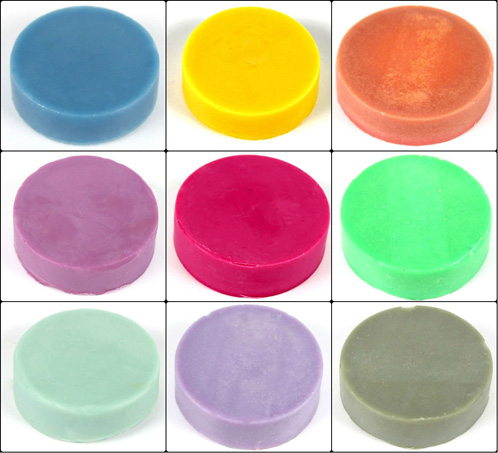
First Row: Azure Blue, Canary, Cimmeron
Middle Row: Grape, Flamingo, Citrus Green
Bottom Row: Gulf Stream, Hyacinth, Java Beans
What is the best usage rate for LabColors?
We have conducted extensive testing to give you precise usage rates for using LabColors in your projects. These usage rates give your soap a vibrant color without producing a colored lather, which can stain.
For 10 of the 12 basic high pH LabColors, we recommend diluting the small size of LabColor in 4 oz. of water, and then following a usage rate of 8 mL of diluted color per pound of soap (this is the total amount of soap you are making, not just the amount of oil in the recipe). These 10 colors are:
For the remaining two colors, Lime and Royal Purple, the usage rate is 4 mL per pound of soap. These colors are more likely to produce a colored lather in finished soaps, and so it’s particularly important to not over-color your products with these two colors.
In melt & pour, LabColors are a what-you-see-is-what-you-get colorant, and we typically recommend using 1/2 teaspoon (about 2.5 mL) of diluted LabColor (the small-sized bottle in 8 oz. of water) per pound of melt and pour soap. To achieve specific colors in melt and pour through blending LabColors, see our Color Mixing Guide, which are available as a hard copy or in digital format.
As an added bonus, we’re providing a helpful chart so you’ll know exactly which LabColor size to purchase based on how much soap you plan to make:
| LabColor Size | Amount of Diluted LabColor (for CP) | Amount of Soap – Light Tint | Amount of Soap – Deep Tint |
| small | 4 ounces | 59 pounds | 15 pounds |
| large | 8 ounces | 118 pounds | 30 pounds |
| jumbo | 50 ounces | 737 pounds | 184 pounds |
Blending Colors
The high pH colors are specially formulated for cold process soap, but they can also be used in melt and pour projects. Keep in mind, the same LabColor may look completely different when used in cold process soap and melt and pour, which is why it is particularly important to only use high pH colors — that won’t morph or discolor — in cold process recipes. We’re giving you the usage rate for the basic 12 colors because you can blend them into hundreds — if not thousands — of other colors by following the ratios listed on our Color Mixing Guide Sheets (you can also buy a digital version of this guide here).
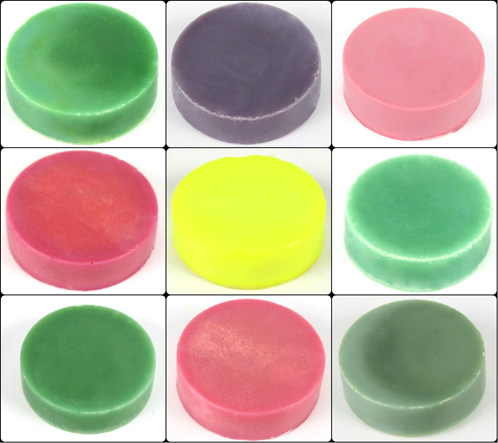
Top Row: Green Wreath, Purple Mist, Berry Red
Middle Row: Vibrant Orange, Lime, Seafoam
Bottom Row: Ivy Mist, Watermelon, Sage
When can I use LabColors?
If you are making cold process soap, take a look at our high pH LabColors that are specifically formulated for all those fun from scratch soapy products. If you aren’t into making cold process soap quite yet, we also have a set of low pH LabColors that can be used in your M&P soaps and pre-made liquid soaps.
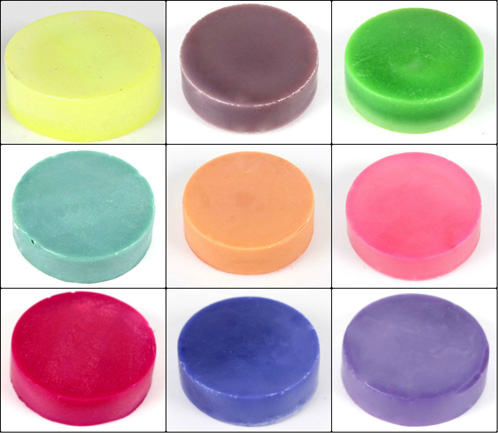
First Row: Lemon, Mauve, Green Apple
Middle Row: Eucalyptus, Soft Orange, Impatien Pink
Bottom Row: Tulip, Royal Blue, Periwinkle
For some fun projects using LabColors (including bath salts, soaps and more), check out the mosaic below. You can use the LabColors in so many different ways and we can’t wait to see what you come with. If you have used our LabColors, be sure to share photos of your creations with us on Bramble Berry’s Facebook page.
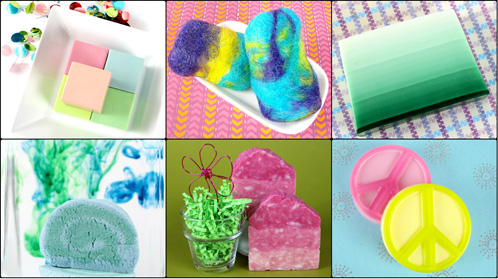
Top Row: Holiday Soap Cubes, All’s Wool That Ends Wool & Green Machine Melt and Pour Tutorial
Bottom Row: How To Make Solid Bubble Bath, Ombre Rebatch Layers & Peace, Love and Soap
We’d love to know what your favorite LabColors are! If you have a tint or shade of color you’d like to see, let us know in the comments below. For a complete list of Bramble Berry LabColors by hue, check out this comprehensive list:
Reds & Pinks: Berry Red, Black Cherry, Brick, Bright Cherry, Countryside Pink, Flamingo Pink, Fuchsia, Magenta, Melon Red, Impatien Pink, Pinkberry Sherbert, Razzberry, Red, Red Velvet, Rio Rose, Santa Red, Tropical Hot Pink, Tropical Red, Tulip, Watermelon, Wineberry Mist, Pinked Mauve, Countryside Amethyst, Pinked Grape, Countryside Mauve
Oranges: Apricot, Countryside Orange, Peach, Orange Sherbert, Orange, Soft Orange, Tangerine, Tropical Orange, Vibrant Orange, Winter Orange,, Mango Sherbert, Cimmeron,
Yellows: Canary, Countryside Sunny Yellow, Countryside Wheat, Lemon, Lemon Sherbert, Sunflower, Tropical Yellow, Marigold
Greens: Citrus Green, Countryside Mint Leaf, Emerald, Eucalyptus Mist, Forest Mist, Green Apple, Lime Sherbert, Ivy Mist, Gulf Stream, Green Wreath, Sage Mist, Seafoam, Soft Jade, Tropical Green, Lime, Java Beans
Blues: Azure Blue, Aqua, Blue Green, Blue Mix, Brilliant Blue, , Countryside Blue Dust, Countryside Blue, Countryside Peacock, Countryside Slate Blue, Countryside Oceana, Pool Blue, Navy, Royal Blue, Sapphire, Sky At Dusk, Sky Blue, Countryside Teal, Teal
Purples: Countryside Plum, Countryside Purple, Easter Purple, Dark Purple, Grape, Lavender High, Lilac, Hyacinth Low, Hyacinth High, Periwinkle, Purple Mist, Purple Passion, Royal Purple, Tropical Purple, Mauve Mist
Browns & Blacks: Vanilla, True Black, Oyster Mist
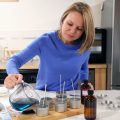
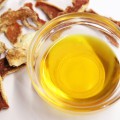
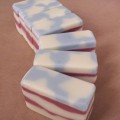

![chamomile[1]](https://www.soapqueen.com/wp-content/uploads/2014/05/chamomile1-120x120.jpg)
Is ther a possibility to dilute 1/4 bottle lab color to 1 oz.distilled water? I only have a 2 oz dropper bottle on hand. Thank you.
Hi Janet!
You can definitely do that if you like! You could also mix 1/2 of the small bottle into 2 ounces of distilled water.
The preservative amount will be a bit tricky to measure because it’s so small (1/4 mL). I would recommend adding a drop or two to help prevent mold and bacteria. 🙂
-Kelsey with Bramble Berry
Droppers: https://www.brambleberry.com/Droppers-With-Suction-Bulb-P3802.aspx
Hi there thanks for the reply. I am recycling dropper bottles that I disenfected by boiling . I should work great!
You’re welcome! Have fun color mixing. 🙂
-Kelsey with Bramble Berry
Hello,
I made a hair product that is only oil and butter based, so I don’t want to add water to my product. I was wondering if it is possible to dilute these in a carrier oil such as coconut oil instead? Thank you.
MsThickHair
Hi there!
Our LabColors come pre-mixed in water, and we’ve found they work best when diluted it water. My worry is that if they’re added directly into oil, they won’t mix in very well.
I think micas would work great in your hair product though! They would add a bit of shimmer to your hair. To use those, add the powder directly to your recipe and stir well to get them fully incorporated. You can also premix them with an oil beforehand, then add the mixed color to your product. That will help prevent clumping or streaking. 🙂
Micas: https://www.brambleberry.com/Micas-C46.aspx
As for a usage rate, I would recommend starting out with a fairly small amount – about 1/8 to 1/4 tsp. per pound of product. If you add a larger amount than that, it may actually color your hair.
-Kelsey with Bramble Berry
Can I use the high ph colors in a M&P soap? There are so many more colors that I like a lot better in the high ph colors!
Hi Meghan!
High pH LabColors are made specifically for cold process soap, so they can morph in melt and pour soap. We do have some other great melt and pour colorants you may like, such as our color blocks! 🙂
-Kelsey with Bramble Berry
Color blocks for melt and pour: https://www.brambleberry.com/Color-Blocks-for-Melt-Pour–C340.aspx
When making shampoo, would I use the low pH or the high pH labcolors? My shampoo tests pH 7!
Hi Melanie!
That’s a great question! A pH level of 7 means your shampoo is neutral and you can use any LabColor you like. However, if you use the high pH LabColors in your finished and balanced shampoo, they may look different than the color swatches I’ll link below. 🙂
You may like our Basic 12 LabColors, which can be used in products with a wide variety of pH levels.
-Kelsey with Bramble Berry
LabColors: https://www.brambleberry.com/LabColors-C171.aspx
Set of 12 LabColors: https://www.brambleberry.com/LabColors-C171.aspx
Digital LabColor Blending Sheet: https://www.brambleberry.com/Digital-LabColor-Blending-Chart-P3815.aspx
I love the lab colors but I am having a hard time with the apricot and tangerine. They fade out to cream colored with only a hue of orange. I have really added in the color and get a really deep orange color and then it fades. Any help on this or am I just going to have to keep working on it? So far I am ok with the pink colors and will try the greens later. I make goats milk CP soap and I bought the olive oil colors but they still turn creamy colors. Thanks, Peggy
Hi Peggy!
Goat milk soap can scald and change the color of your LabColors. We recommend freezing your goat milk before you add the lye to prevent scalding, and doing a 50/50 mixture of milk and water to get a nice color. 🙂
Also, where are you storing your soaps? They can fade in direct sunlight, so we recommend storing them in a dark place.
Another tip is adding a couple more drops of color to see if that helps!
-Kelsey with Bramble Berry
Ok, I’m still confused about this. If I didn’t dilute before, it looks like I need to use 10x as much to get the same color in my soap?
Hi Trish!
Once diluted, you will have “more” colorant because you have added water, giving you larger amount of LabColor. If you don’t dilute your LabColor, it’s true that you would use more concentrated dye. Because we don’t recommend it, we do not include usage rates for undiluted dye. I hope this answers your question 🙂
-Amanda with Bramble Berry
No it doesn’t. I am assuming that the new colorants are now already diluted 10x what the were before. This is why I asked for the conversion before diluting. If I used 8 oz to dilute before now since (I’m assuming it is already diluted 10x more) I should dilute less? For me, it’s just easier to figure out without out adding dilution rates in.
Thanks!
Trish
Thanks for the tutorial. Unfortunately I’m still a bit confused on this. If I purchased a 20 ml Labcolor previously and added 16 oz. of distilled water to dilute, what size should I purchase now and how much water should I dilute it with to get the same results as before and not mess up my recipes? If I lets say, used to use 1 tbs. of red Labcolor in a given recipe, would I still use 1 tbs. once diluted, like before, or would I have to use a different amount? Your recommendations per lb are based on ml and they were previously in tablespoons so I’m unsure how to convert that. I was unclear if the concentrations of your labcolors had changed at all. I really don’t want to have to redo all my recipes. Also, do you HAVE to use a preservative? How long would it take to have “nasties” in your colors and how would you know if you got them or not? If accidentally used, would it then ruin your batch of soap, or would it still be ok to use? Thanks for your help!
Hi Melissa!
We are so sorry about any confusion you may be having about the LabColor change. If you purchased a 20 mL of LabColor before, you can still dilute it in anywhere from 8-16 ounces (your choice). We like using 8, but we always suggest experimenting with the dilution rate a bit until you find one that works perfectly for you!
If you were using the 20 mL before, you would now purchase the Large (20 ML) and still be able to get the same results as before. The amount of colorant you use in your soaps hasn’t changed, the only thing that we changed was the preservative and how much water was in the initial product.
We do suggest having a preservative in your LabColors, as that will make them last much longer than if you didn’t. If you choose not to use preservative, you can store them in your refrigerator for up to 2-3 weeks. If you did use LabColors in a batch of soaps without using preservatives, it should be fine, but you will want to keep an eye on it!
I hope that this helps to answer your questions. If there is anything else we can do for you, let us know! =)
-Becky with Bramble Berry
Wow these colors look great! I only make melt and pour soaps and have only used color blocks. The color blocks are nice but a bit time consuming to shave the perfect color. I think I might try these sometime!
Hi Leanna!
We just love the LabColors for those bright splashes of color in our soaps. If you do end up trying out our LabColors, let us know what you think! =)
-Becky with Bramble Berry
Is the amount of Optiphen enough to keep “the nasties” at bay after dilution in distilled water, or do I still need to add a preservative?
My favorite Labcolor so far is Eucalyptus Mist – so pretty! I’d love to find a yellow-green that would go well with Lemon Verbena FO.
Oh, and thank you!!! for the expected usage chart – that’s great for figuring out how much soap that little bottle will color! Now, can you do the same for clays, micas, and pigments? (please? I have no idea how many teaspoons are in an ounce of clay!)
Hi Elizabeth!
You will still need to add a preservative to your LabColors after you have diluted them as the preservative in the ones you purchase from Bramble Berry is only enough to keep the product (colorant) from growing any nasties. We would suggest sticking with the Optiphen ND as it works great for us!
Optiphen ND: https://www.brambleberry.com/Optiphen-ND-P5714.aspx
Thank you so much for your feedback on the LabColors. We always love to hear what our customers think. If you get a chance, we’d love for you to leave a review on the Eucalyptus Mist product page!
Eucalyptus Mist: https://www.brambleberry.com/Eucalyptus-Mist-LabColor-P4361.aspx
Did you know that you can mix and blend LabColors until you get a hue that you are going for? I would try a yellow like Canary and add a pinch of your favorite green LabColor to get the shade you were going for.
Canary LabColor: https://www.brambleberry.com/Canary-LabColor-P3013.aspx
We also have this great blog that I constantly refer to that gives you the usage rates for our oxides, micas and more. Here is the link:
Talk It Out Tuesday: Colorants: http://www.soapqueen.com/bath-and-body-tutorials/tips-and-tricks/talk-it-out-tuesday-colorants/
I hope that this helps! Let us know if you have any other questions. =)
-Becky with Bramble Berry
Thanks as always for the info! However, what I’d like to know is how many pounds of soap I can color with certain quantities of clays, micas, and pigments. The usage rates in the recipes are in teaspoons, but the colors are sold on the BB site in ounces. I don’t know how many teaspoons are in an ounce of clay, for example.
It’s probably a big project, but I would LOVE to know how many pounds of soap I can color with an ounce (or four, or a pound) of other colorants too.
That kind of info is really helpful when deciding which type of colorant to purchase, especially when someone is new to soaping, like me. 🙂
Hi Elizabeth!
Every colorant is different for usage rate, so that can be a bit tricky. For example, clays are always WYSIWYG (What You See Is What You Get), so it depends on how much you actually want to add to your soap.
Clays: https://www.brambleberry.com/Clays-C48.aspx
With the other colorants, it really depends on whether you are making cold process or melt & pour and the type of colorant. For micas in cold process, about 2 teaspoons will color a pound of soap (lye + water + oils/butter). In one ounce of colorant, there is about 6 teaspoons. But, if you are making melt & pour about 1/2 a teaspoon will color a pound of soap.
Micas: https://www.brambleberry.com/Micas-C46.aspx
For pigments and oxides, 1/2 teaspoon of oxide (pre-dispersed in a fixed oil) will color a pound of cold process soap, while 1/16th to 1/8th teaspoon while color a pound of melt & pour soap.
Pigments: https://www.brambleberry.com/Pigments-C45.aspx
For an easy to conversion rate from ounces to teaspoons/tablespoons (and vice versa) I use Google! I just type in “ounce to teaspoon conversion” and it pops up with a handy calculator.
I hope that this helps! =)
-Becky with Bramble Berry